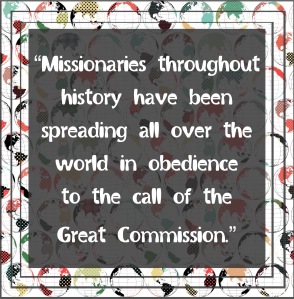Author’s Note: This is the last post in a short series on The History of the Modern Missions Movement. You can read the other two posts here and here. Thank you for reading.
In the Bible we are told Priscilla and Aquila accompanied Paul on one of his missionary journeys. From that time until now women have played an integral role in missions.
Early on, male missionaries realized that “contact with women in most non-Western societies was impossible for them,” so they brought their wives with them to the field in order to reach these women.[1] These missionary wives “received little recognition for the heavy load they carried, managing the home and children as well as developing programs to reach local women and girls.”[2]
Single women could go to the field to help take care of missionary children or to minister alongside missionary families.[3] However, that all began to change and single women gained opportunities such as supervising “women’s schools.”[4] These single women became leaders on the mission field.[5] Kraft and Crossman write “Leaders such as Annie Armstrong and Helen Barret Montgomery dedicated themselves to developing missionary prayer groups, raising funds, and mobilizing Christians to support fieldwork of all kinds.”[6]
During the Civil War so many men lost their lives that a large amount of women were widowed or did not marry.[7] As a result, they took on many other responsibilities of men.[8] According to Kraft and Crossman, the women “ran businesses, banks, farms, formed colleges, and for the next 50 years inherited a larger role then men as the major muscle of the mission movement.”[9]
Missionary boards declined sending women to the field, so instead the women “organized their own boards.”[10] The first of such boards was the “Women’s Union Missionary Society.”[11] By 1900, 100,000 women societies existed in “over 40 denominational societies for women, with over 3 million active women raising funds to build hospitals and schools around the world, paying the salaries of indigenous female evangelist and sending single women as missionary doctors, teachers, and evangelist.”[12]
Kraft and Crossman point out that women were more willing to take the dangerous assignments than men were.[13] However, by the 20th century the women missionary boards combined their efforts with their respective denominational boards, and “in the 1920s and 1930s, women gradually lost their opportunity to direct the work.”[14] Nevertheless, according to Kraft and Crossman, “two-thirds of the missionary field has been and currently is female.”[15]
Men and women with conviction in their hearts set the standard for the modern missionary movement. Their passion to reach the lost proves to be contagious as more and more missionaries go forth to spread the Gospel. Hudson Taylor launched missions into mainland China in obedience to that call that God had placed in his life. William Carey similarly set out to evangelize India because of what he considered that God had shown him through His Word. Many more men and women gave their lives on the mission field for the furtherance of the Gospel, as was noted in the deaths of missionaries going to Africa.
The mission of the church is found in Matthew 28 and is the primary task at which the church is to engage itself. Secondary to this mission is the spiritual growth of the Christian and the response to the needs of the poor. The nature and mission of the church is intertwined in such a way that the church owes its existence to its mission. These men and women who set out to evangelize the world in the 19th century to the present understood this fact. As a result, the birth of the modern missions movement came out of a Spirit-led desire to see the lost saved.
[1] Kraft, Marguerite and Crossman, Meg “Women in Mission.” Perspectives: On The World Christian Movement, edited by Ralph D. Winter and Steven C. Hawthorn, 269-274. Pasadena, CA: William Carey Library, 1999, 270.
[2] Ibid., 270.
[3] Ibid., 270.
[4] Ibid., 270.
[5] Ibid., 270.
[6] Ibid., 270.
[7] Ibid., 271.
[8] Ibid., 271.
[9] Ibid., 271.
[10] Ibid., 271.
[11] Ibid., 271.
[12] Ibid., 271.
[13] Ibid. 271.
[14] Ibid., 271.
[15] Ibid., 271.




Isn’t it odd that churches like the Southern Baptists will take up the Annie Armstrong or Lottie Moon offering in the name of two women, but it’s leadership (all men) won’t fund or support the women’s missionary union in their own denomination, forcing it to cease much of it’s operation? Women didn’t just gradually lose the freedoms to serve, they were systemically stolen by the the denominations they represented. I just wish that women with a calling to lead had more choices than missionary work, and that missionaries had more resources to carry out their mission. Trying to force women off of the mission field isn’t going to spread the gospel any faster, and keeping women from preaching and teaching is just holding back other men and women who would have heard the gospel otherwise.